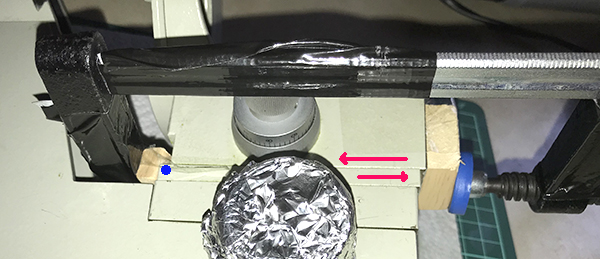
|
Topical Tip - Using F clamps for seized microscope focus dovetails using the Russian LOMO Biolam as an example. by David Walker, UK |
I recently volunteered to take a look at a non-working LOMO Biolam microscope that had been in storage for many years to see whether it could be brought back into use. I still own my example, it was the first proper affordable microscope I bought over forty years ago. My brother Ian and I had also serviced a number over the years so I was prepared for potentially seized parts; Russian microscopes used a thick grade of somewhat acidic grease which tended to solidify and also potentially attack the brass mating surfaces.
In the past, adding penetrating fluid to seized dovetails and hair dryer warming invariably freed them after reapplying this treatment over a week or so. The condenser focus eventually responded as they were the smallest surface area mating surfaces. Fortunately the plastic rack was undamaged. However, both the coarse and fine focus resolutely refused to succumb to this treatment. So what was left in the armoury, a vice with very large jaws (not owned) or a hammer? I'm reluctant to use percussive force as uncontrolled so tried some F clamps. I did not own any but a pair sell for about £9 new on eBay UK. I bought the Silverline 150 x 50 mm size which are sturdy all metal and turned out to be the ideal size of a number on offer.
The advantage of clamps is that they can present a controlled force along the linear axis of the dovetails. After some trial and error to devise what worked best, both the coarse and fine focus dovetails were released with this treatment while also applying the hairdryer and fortunately no historical damage to the focus mechanisms; past users may have been tempted to try force on the focus as the system became stiffer. There may be other microscope models with designs where a similar treatment could be applied if other methods have failed.
General notes:
- With seized dovetails at no stage were the knobs with gears engaged tried to free the dovetails. It is likely that the small gear teeth could suffer damage by the type of forces likely to be needed. Only the dovetails themselves were acted on.
- In the example on the Biolam below, the fine focus is a modular mechanism which has been removed. The right hand coarse knob also unscrews and the pinion shaft pulls out partially to disengage it from the rack. It is strongly recommended that if at all possible any gears are disengaged and focus modules removed before using this approach. The sort of forces required to loosen the dovetails can be high, safe enough on just dovetails but could potentially damage any engaged gearing.
- Hair dryers should only be used when all optics are removed from the microscope but still with care; hand hot was the highest temperature the metal was allowed to reach. A heat gun is not recommended as likely too hot and could damage paintwork. The plastic knobs were shrouded in foil to keep them cool. Plastic, especially aged, may have become brittle.

The clamp set up to release the fine focus dovetail which moves with the arrows shown. Placement of the clamps needs care to ensure acting just on the correct surfaces which can be small. The gap marked in blue is being exploited to free the first few mm. The mechanical fine focus module has been removed so the vernier fine focus knobs are not engaged with any gears. Wooden blocks spread the load and avoid damaging the surfaces. Black tape has been used on the clamp rod and left hand jaw for the same reason. The unit had been warmed with a hairdryer.

The clamp set up to release the coarse focus dovetail. With the plastic jaw protector off the left hand jaw it sat conveniently in the recess of the limb. The block marked in red
raised the jaw away from the internal flat to allow movement. The hair dryer was clamped in a retort stand to allow increasing pressure using the clamp screw handle right. This required a surprising amount of force to free the surfaces. Percussive force likely could have caused damage.
Although not shown, after the dovetails started to move, the clamp was reversed and was long enough for the disc on the screw end which was on a ball joint to mate on the top of the angled limb to start the dovetails moving in the other direction.
The pinion on the knobs had been disengaged as remarked above before starting to use the clamp. There was a remaining intermediate gear still acting on the rack but no way of disengaging this. Fortunately all gears were in good condition after release.
For both the above setups white spirit had been dripped into the dovetail edges over a week and regular warming, insufficient treatments alone to release the dovetails manually. I prefer white spirit, it is non-polar and does not attack the Biolam paint or plastics. Some grades of WD-40 type fluids contain silicone and can leave sticky deposits.
Comments to the author David Walker are welcomed.
Published in the March 2021 edition of Micscape.
Please report any Web problems or offer general comments to the Micscape Editor .
Micscape is the on-line monthly magazine of the Microscopy UK web site at Microscopy-UK
© Onview.net
Ltd, Microscopy-UK, and all contributors 1995 onwards. All rights
reserved.
Main site is at www.microscopy-uk.org.uk
with full mirror at
www.microscopy-uk.net
.